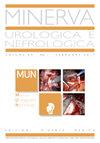Comparison of multiple abbreviated multiparametric MRI-derived protocols for the detection of clinically significant prostate cancer.
Q1 Medicine
引用次数: 5
Abstract
BACKGROUND To compare the accuracy of multiple abbreviated multiparametric magnetic resonance imaging (mpMRI)-derived protocols in detecting clinically significant prostate cancer (csPCa). METHODS 108 men undergoing staging 3.0T mpMRI with a Prostate Imaging - Reporting and Data System version 2 (PI-RADSv2)-compliant protocol before radical prostatectomy (RP) were retrospectively evaluated. Two readers (R1, R2) independently analyzed mpMRI, assigning a PI-RADSv2 category to each observation as appearing on each examination sequence. A study coordinator assessed final PI-RADSv2 category by combining readers' assignments according to four protocols: short MRI (sMRI) (diffusion-weighted imaging + axial T2-weighted imaging), contrast-enhanced short MRI (cesMRI) (sMRI + dynamic contrast-enhanced [DCE] imaging), biparametric MRI (diffusion-weighted imaging + multiplanar T2-weigthed imaging), and mpMRI. Using RP pathology as the reference standard for csPCa, we calculated the per-lesion cancer detection rate (CDR) and false discovery rate (FDR) for each MRI protocol (cutoff PI-RADSv2 category ≥3), and the per-PI-RADSv2 category prevalence of csPCa and false positives. RESULTS Pathology after RP found 142 csPCas with median International Society of Urogenital Pathology grade group 2, and stage ≤pT2c in 68.6% of cases. CDR was comparable across the four MRI protocols (74.6% to 75.3% for R1, and 68.3% for R2). FDR was comparable as well (14.4%-14.5% for R1 and 11.1% for R2). sMRI was the minimum protocol equaling mpMRI in terms of CDR, although cesMRI, similarly to mpMRI, was associated with fewer PI-RADSv2 category 3 assignments and higher prevalence of csPCa within PI-RADSv2 category 3 observations (66.7% versus 76.9% for R1, and 100% versus 91.7% for R2, respectively). CONCLUSIONS Among multiple abbreviated mpMRI-derived protocols, cesMRI was the one equaling mpMRI in terms of csPCa detection and minimizing PI-RADSv2 category 3 assignments.多个简化的多参数mri衍生方案用于检测临床意义的前列腺癌的比较。
背景:比较多个简化多参数磁共振成像(mpMRI)衍生方案在检测临床显著性前列腺癌(csPCa)中的准确性。方法回顾性分析108例在根治性前列腺切除术(RP)前接受3.0T mpMRI分期并符合前列腺影像学报告和数据系统版本2 (PI-RADSv2)标准的男性。两个阅读器(R1, R2)独立分析mpMRI,为出现在每个检查序列上的每个观察分配PI-RADSv2类别。研究协调员通过结合读者的作业,根据四种方案评估最终的PI-RADSv2类别:短时间MRI (sMRI)(弥散加权成像+轴向t2加权成像)、对比增强短时间MRI (cesMRI) (sMRI +动态对比增强[DCE]成像)、双参数MRI(弥散加权成像+多平面t2加权成像)和mpMRI。以RP病理作为csPCa的参考标准,计算各MRI方案的每病灶癌检出率(CDR)和假发现率(FDR)(截断PI-RADSv2分类≥3),以及csPCa的每PI-RADSv2分类患病率和假阳性。结果术后病理检查发现142例cspca,国际泌尿生殖病理学会分级中位数为2组,68.6%的病例分期≤pT2c。四种MRI方案的CDR具有可比性(R1为74.6%至75.3%,R2为68.3%)。FDR也具有可比性(R1为14.4%-14.5%,R2为11.1%)。在CDR方面,sMRI是与mpMRI相当的最低方案,尽管cesMRI与mpMRI相似,在PI-RADSv2 3类观察中,较少的PI-RADSv2 3类分配和较高的csPCa患病率相关(R1为66.7%对76.9%,R2为100%对91.7%)。结论在多个简化的mpMRI衍生方案中,cesMRI在csPCa检测和最小化PI-RADSv2 3类分配方面与mpMRI相当。
本文章由计算机程序翻译,如有差异,请以英文原文为准。
求助全文
约1分钟内获得全文
求助全文
来源期刊

Minerva Urologica E Nefrologica
UROLOGY & NEPHROLOGY-
CiteScore
5.50
自引率
0.00%
发文量
0
审稿时长
>12 weeks
期刊介绍:
The journal Minerva Urologica e Nefrologica publishes scientific papers on nephrology and urology. Manuscripts may be submitted in the form of Minerva opinion editorials, editorial comments, original articles, video illustrated articles, review articles and letters to the Editor.
 求助内容:
求助内容: 应助结果提醒方式:
应助结果提醒方式:


